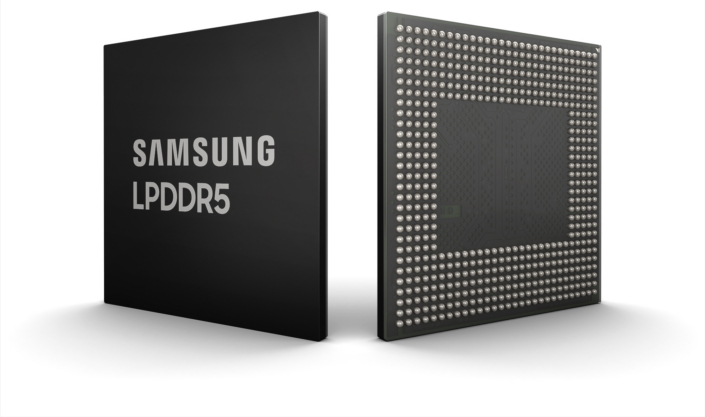Long-term use of “non-blocking” is pretty much basic for most mobile smartphones. But from Xiaomi’s point of view, “non-blocking” is just a very basic industry standard. On top of this, Xiaomi phones have always insisted on pursuing higher performance at the cost of hardware. As early as February 2019, JEDEC (Solid State Technology Association) released the LPDDR5 low-power memory standard. One year later, LPDDR5 memory is finally successfully commercialized. The world’s first LPDDR5 memory inside the Xiaomi Mi 10 series has once again led the industry.
LPDDR5: More Speed at Less Power Consumption!
The first is higher speed, thanks to the multiple bank group mode, more parallel data paths are added inside the LPDDR5 device, which increases data bandwidth and thus improves performance. Compared with the previous generation LPDDR4, the data transfer rate of LPDDR5 has drastically increased from 3200Mbps to 5500Mbps. This is the memory specification with the highest speed at present.
At present, other mobile manufacturers on the market support LPDDR4x (4266Mbps) which is already the highest level, this is obviously on a different playing ground from LPDDR5. Compared with the top flagships on the market, the Xiaomi Mi 10 has substantially improved memory performance by an incredible 30%, and in the future, there will be 6400Mbps LPDDR5 memory with higher specifications, therefore pushing the performance far better by 50%!
The second benefit is lower power consumption. Compared with LPDDR4X, the VDD2 power supply of LPDDR5 is divided into VDD2H and VDD2L, where VDD2H is reduced from 1.1V to 1.05V, and VDDQ is reduced from 0.6V to 0.5V. At the same time, newly added DVSFS and DVFSQ functions, dynamically adjust the working voltage according to the operating frequency, and at low speeds, switch VDD2H and VDDQ to lower 0.9V (VDD2L) and 0.3V respectively to further reduce power consumption.
In addition, when the LPDDR4x device operates at high speed, the clock is 2133MHz, and it needs to be kept in this state all the time, which will increase power consumption virtually. The LPDDR5 device has modified this design. The clock of LPDDR5 is only 800MHz. When the data is read or written, there will be a WCK signal. This WCK signal will reach the maximum operating frequency, after that it will stop, therefore reducing power consumption.
Having said and done, now what are the benefits of LPDDR5?
We know that the CPU is the core component for data calculation/processing in mobile phones. It runs very fast, but the disadvantage is that the storage space is very small. Flash memory has a large storage space and is used to store various data such as programs, but it is very different from the speed of the CPU. This requires the hub of memory to conduct data and instructions to match the speed of data processing and data transmission, and the program runs in memory. Without memory, the overall processing speed of the CPU would be severely slowed down at a drastic rate.
The current state that smart phones need to deal with is accelerating, which places higher requirements on the phone’s ability to process data instantly (that is, memory performance). The Xiaomi Mi 10 is equipped with an LPDDR5 memory rate of 5500Mbps, which is equivalent to transmitting 44GB of data per second, which is about 12 HD video files (3.7GB / pc). The CPU transfers the data that needs to be calculated into the memory, and returns the result after the operation is completed. Memory is critical to the stable operation of the phone, and high-performance memory is of great benefit to the improvement of the overall fluency of the phone.
For example, taking pictures on mobile phones involves a lot of data calculations, especially now that mobile phone camera pixels have reached 100 million. Poor memory performance and slow data transmission can cause delays in taking pictures.
In such a special scenario in 2020, the popularity of 5G networks is fast gaining grounds. Scenarios such as 5G online gaming and AI computing will bring a doubled increase in terminal data throughput. LPDDR5 high-performance memory can effectively reduce cloud game latency and ensure real-time synchronization of AI computing data, which provides sufficient terminal performance guarantee for the derivation and development of 5G-related services. LPDDR5 is not only standard for Xiaomi Mi 10 series flagships, but also standard for the advancement of technology.In addition, because LPDDR5 has many improvements and optimizations in power consumption, according to Xiaomi users’ endurance DOU test results, LPDDR5 has obvious endurance advantages over LPDDR4X.
1. In the comprehensive scenario, user life is increased by about 10%.
2. In the game (Glory of Kings) scene, power saving is about 20%.
3. In WeChat voice and video scenarios, power saving is about 10%.
There is also a full range of UFS 3.0 high-speed flash memory that doubles performance
The data processing inside the mobile phone is actually a relay process. It is like transporting goods. If you use a rocket to send the first half, you can’t use a ox cart in the second half. The Mi 10 series is equipped with UFS 3.0 flash memory that matches the performance of LPDDR5, which is also the fastest flash memory in the industry to date. UFS supports two-way bidirectional reading and writing. The bandwidth of UFS 3.0 interface is up to 2900MB / s, which has doubled the performance compared to 1450MB / s of UFS 2.1.
In addition to the difference in interface speed, the interface voltage of UFS 3.0 is also lower than UFS2.1. The VCC power supply for flash memory particles has been reduced from 2.9V to 2.5V, and the VCCQ powering the main control has been directly reduced from 1.8V to 1.2V. The reduction of the interface voltage has a strong effect on reducing the power consumption and heat generation of the device.
The test results show that the power consumption per GB / s sequential read of UFS3.0 is 60% lower than UFS2.1, and the power consumption per GB / s sequential write is 48% lower than UFS2.1.
UFS 3.0 measured: copy 11GB file, only 23 seconds
Test results from different types of flash memory with a capacity of 128GB Xiaomi phones, and use AndroBench (version 5.0.1) software.
It can be seen from the measured data that Xiaomi Mi 10 equipped with UFS 3.0 flash memory has a significant increase in flash memory read-write performance compared to the previous generation Xiaomi Mi 9. The sequential read speed is twice that of Xiaomi 9, the sequential write speed is 3.9 times that of Xiaomi 9, the random read speed is 1.7 times that of Xiaomi Mi 9, and the random write speed is 1.7 times that of Xiaomi Mi 9.
This directly affects the user’s experience, and the speed difference in terms of large file copying, application installation, and game loading is particularly obvious. The following is a comparison of UFS 3.0 and UFS 2.1 in three scenarios. (Xiaomi 10 Pro 256GB VS Xiaomi 9 256GB)
Copying a compressed file of 11.17GB in the phone, Xiaomi Mi 10 Pro took 23 seconds, and the overall speed was basically maintained at around 500MB / s, which is very stable. The Xiaomi Mi 9 took about 60 seconds and the speed floated between 145MB / s and 335MB / s. There is a huge difference in speed.
Install the game “Peace Elite”, the installation package size is 1.9GB, and the Xiaomi 10 Pro takes 12 seconds. Xiaomi Mi 9 took 19 seconds.
From clicking the “Peace Elite” icon to entering the game completely, Xiaomi Mi 10 Pro takes 18 seconds and Xiaomi Mi 9 takes 22 seconds.
Above, we can see the huge advantages of UFS 3.0 flash memory compared to UFS 2.1 flash memory in terms of read and write performance. In the actual use of mobile phones, data is read and written at all times. Other scenarios such as reading photos, opening apps, saving photos, playing local videos, etc., the quality of flash memory directly affects the user experience if its smooth or not.
In addition, the speed gap between the new UFS 3.0 and UFS 2.1 flash memory is not particularly obvious. As the use time increases, more and more things are stored in the flash memory, and the speed gap when the mobile phone calls data will be more obvious. The performance of the flash memory is also related to whether the mobile phone can still stay smooth after long-term use.
In 2020, 5G is accelerating, and the popularity of various technologies is faster than in the past, driving mobile phones to iterate faster. All Xiaomi Mi 10 series phones are equipped with LPDDR5 + UFS 3.0, which is the top configuration before the times, which is a powerful guarantee for the terminal experience.
What do you think of this article? Is speed important to you or not? Sound of below.

